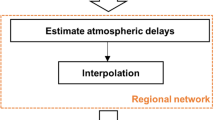Abstract
Pseudorange-based integrity monitoring, for example receiver autonomous integrity monitoring (RAIM), has been investigated for many years and is used in various applications such as non-precision approach phase of flight. However, for high-accuracy applications, carrier phase-based RAIM (CRAIM), an extension of pseudorange-based RAIM (PRAIM) must be used. Existing CRAIM algorithms are a direct extension of PRAIM in which the carrier phase ambiguities are estimated together with the estimation of the position solution. The main issues with the existing algorithms are reliability and robustness, which are dominated by the correctness of the ambiguity resolution, ambiguity validation and error sources such as multipath, cycle slips and noise correlation. This paper proposes a new carrier phase-based integrity monitoring algorithm for high-accuracy positioning, using a Kalman filter. The ambiguities are estimated together with other states in the Kalman filter. The double differenced pseudorange, widelane and carrier phase observations are used as measurements in the Kalman filter. This configuration makes the positioning solution both robust and reliable. The integrity monitoring is based on a number of test statistics and error propagation for the determination of the protection levels. The measurement noise and covariance matrices in the Kalman filter are used to account for the correlation due to differencing of measurements and in the construction of the test statistics. The coefficient used to project the test statistic to the position domain is derived and the synthesis of correlated noise errors is used to determine the protection level. Results from four cases based on limited real data injected with simulated cycle slips show that residual cycle slips have a negative impact on positioning accuracy and that the integrity monitoring algorithm proposed can be effective in detecting and isolating such occurrences if their effects violate the integrity requirements. The CRAIM algorithm proposed is suitable for use within Kalman filter-based integrated navigation systems.








Similar content being viewed by others
References
Brown RG (1992) A baseline GPS RAIM scheme and a note on the equivalence of three RAIM methods. Navigation 39(3):301–316
Brown RG, Chin YG (1998) GPS RAIM: calculation of thresholds and protection radius using Chi-square methods-a geometric approach. Navigation V:155–178
Chang XW, Paige CC, Studenny J (2000) Two carrier phase based approaches for autonomous fault detection and exclusion. Proceedings of ION GPS, Salt Lake City, 19–22 September, pp 1895–1905
Chang XW, Paige CC, Perepetchai V (2001) Integrity methods using carrier phase. Proceedings of International Symposium on Kinematic Systems in Geodesy, Geomatics and Navigation (KIS 2001), Banff, June 5–8, pp 235–245
De Jonge P, Tiberius C (1996) The LAMBDA method for integer ambiguity estimation: implementation aspects. Tech Rep. 12, Delft Geodetic Computing Centre, IGR-series
Diesel J and Luu S (1995) GPS/IRS AIME: Calculation of thresholds and protection radius using Chi-square methods. Proceedings of ION GPS 1995, Palm Springs, 12–15 September, pp 1959–1964
Heo MB, Pervan B, (2003) Airborne autonomous fault detection for shipboard landing navigation using carrier phase DGPS. Proceedings of ION NTM, Anaheim, 22–24 January, pp 441–453
Hide C, Moore T, Hill C (2006) Development of a multi-sensor navigation filter for high accuracy positioning in all environments. Proceedings of ION GNSS, Fort Worth, 26–29 September, pp 1635–1644
Hofmann-Wellenhof, Lichtenegger H, Collins J (2001) GPS theory and practice, 5th edn. Springer, New York pp 189–202
Lau L, Cross P (2007) Development and testing of a new ray-tracing approach to GNSS carrier-phase multipath modeling. Journal of Geodesy 81(11):713–732
Lee YC, Laughlin DG (1999) A performance analysis of a tightly coupled GPS/inertial system for two integrity monitoring method. Proceedings of ION GPS, Nashville 14–17 September, pp 1187–2000
Mehra R (1970) On the identification of variances and adaptive Kalman filtering. IEEE Trans Aerosp Electron Syst 15:175–184
Michalson W, Hua H (1995) GPS carrier-phase RAIM. Proceedings of ION GPS, Palm Springs, CA, 12–15 September, pp 1975–1984
Pervan B, Lawrencwe DG, Parkinson RW (1998) Autonomous fault detection and removal using GPS carrier phase. IEEE Trans Aerosp Electron Syst 34(3):897–906
Pervan B, Lawrencwe DG, Cohen CE, Parkinson RW (1996) Parity space methods for autonomous fault detection and exclusion using gps carrier phase. Proceedings of IEEE PLANs, Atlanta, GA, 22–26 April, pp 649–656. doi:10.1109/PLANS.1996.509141
Pervan B, Chan F et al (2003) Performance analysis of carrier phase dgps navigation for shipboard landing of aircraft. Navigation 50(3):181–191
Teunissen PJG (2005) Integer aperture bootstrapping: a new GNSS ambiguity estimator with controllable fail-rate. J Geod 79(6–7):389–397. doi:10.1007/s00190-005-0481-y
Acknowledgments
This paper is based on the research carried out within the SPACE project. SPACE (Seamless Positioning in All Conditions and Environments) is an EPSRC-funded collaborative research project. It began life as a Pinpoint Faraday flagship project but, following the evolution of Pinpoint into a Knowledge Transfer Network (KTN), now operates within the Location and Timing KTN (http://www.locationktn.com). The project is being undertaken by a consortium of eleven UK university and industrial groups. The university groups are the School of Electrical and Electronic Engineering at the University of Leeds, the Department of Civil and Environmental Engineering at Imperial College London, the Department of Geomatic Engineering at University College London (UCL), the Institute of Engineering Surveying and Space Geodesy at the University of Nottingham, and the industrial partners are the UK Civil Aviation Authority, EADS Astrium, Leica Geosystems, Nottingham Scientific Ltd, Ordnance Survey, QinetiQ and Thales Research and Technology.
Author information
Authors and Affiliations
Corresponding author
Rights and permissions
About this article
Cite this article
Feng, S., Ochieng, W., Moore, T. et al. Carrier phase-based integrity monitoring for high-accuracy positioning. GPS Solut 13, 13–22 (2009). https://doi.org/10.1007/s10291-008-0093-0
Received:
Accepted:
Published:
Issue Date:
DOI: https://doi.org/10.1007/s10291-008-0093-0




